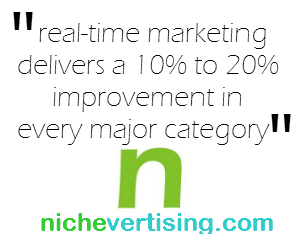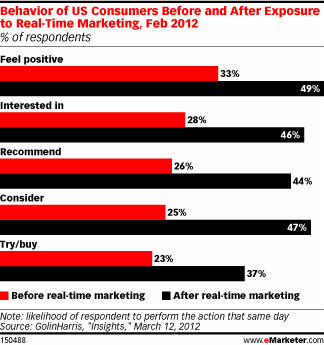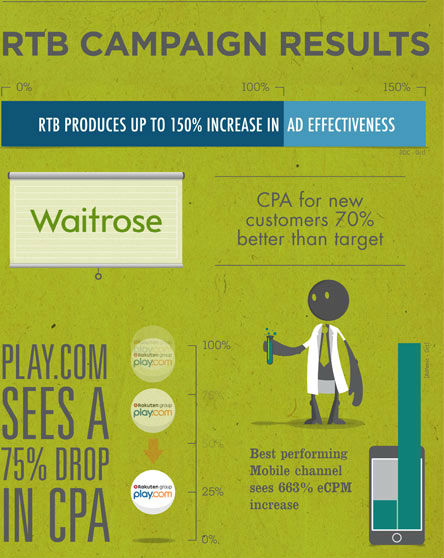 The digital landscape for marketers is changing fast. As a result of social and mobile going mainstream, the last three years has ushered in an era that dovetails with two bigger marketing trends:
The digital landscape for marketers is changing fast. As a result of social and mobile going mainstream, the last three years has ushered in an era that dovetails with two bigger marketing trends:
1) Increased spending in overall marketing budgets, up 6% from 2012 to 2013 (Gartner) and
2) A sharp shift to digital over traditional marketing with a more than doubling of the number of firms spending over 50% of their marketing budget on digital in 2013 ( 23% vs. only 11% in 2012, Accenture).
Real-Time Marketing Trends in 2013
With an increase in spending on digital advertising you can expect online marketers to make greater investments in traditionally complex real-time marketing solutions.
These solutions are regarded as complex due to there dependency on more resources than historical seen as acceptable.
This includes either a dedicated management staff as what is required in manual real-time marketing, or the reliance on the analysis of large data sets as what is required to automate real-time bidding.
Real-Time Marketing
Real-time marketing is a trend that emerged as a result of Twitter. With the emergence of Twitter as a legit communication and marketing tool, the real-time web is now a reality.
With this reality of the real-time web comes the need for real-time marketing. That is, the ability to respond to people individually as well as in groups immediately as events unfold.
Real-time marketing hit the mainstream as a result of the success of Oreo’s “Dunk in the Dark” tweet during the 2013 Super Bowl black-out.
Power out? No problem. twitter.com/Oreo/status/29…
— Oreo Cookie (@Oreo) February 4, 2013
Other than it being cool to respond to events with real-time marketing, it actually improves consumer’s perception of a brand and makes it more likely that they will buy. Check out this chart below published May 7th, 2013 on eMarketer.com in an article titled The Real-Time Marketing Drumbeat Gets Louder, as Agencies, Brands Sign On:

As you can see, real-time marketing delivers a 10% to 20% improvement in every major category of consumer behavior. Anytime you see results like this, you can expect spending to increase until the market get saturated which may take another 3 to 5 years.
Real-Time Bidding
Real-time bidding (RTB) is a trend that emerged as a result of what is called “big data” capabilities. Big data is more or less a collection of data about people, places, and things so large that no one could fathom how to make it useful 10 years ago.
However, as a result of increased computing power, several tech solutions have emerged capable of slicing and dicing this data to create decision support products that were unimaginable just 3 to 5 years ago.
Real-time bidding is one of these products. RTB is a sea change in the way digital display advertising is delivered to your screen.
In the past, everyone who landed on a web page would more or less see the same rotation of banner ads.
In today’s RTB market, every individual has the potential to see a unique ad targeted specifically to them based on everything from the cookies within their brower, their social media activity, and their search history.
On top of this, advertisers have the ability to bid against each other in real time (decision made within a 100th of a milliseconds) for the potential to show you their ad.
On the one hand, this can appear really creepy when you keep getting shown the same ad over and over again after you search for something as in the case of what’s called ad retargeting. On the other hand, advertisers say this helps make sure you are seeing ads that are relevant to you and will make your web surfing experience more pleasant.
The data supports the claim of advertisers. In 2012, when advertisers used real-time bidding to serve display ads, some saw from a 70 -75% decrease in the cost to acquire a customer and the effectiveness of ads were perceived by consumers to be 150% better according to this infographic snippet below from Infectious Media.

